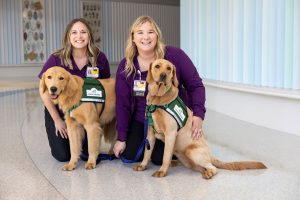U-I Children’s Hospital now using dogs to help kids
August 31st, 2023 by Ric Hanson
(Radio Iowa) The University of Iowa’s Stead Family Children’s Hospital is joining a growing trend in bringing in dogs to work with young patients. Dog handler Emily Bradley says the goal of dogs Nacho and Corrin is to help kids understand their diagnosis and reduce the fear and anxiety they may feel. “We kind of use that unique human animal bond between, you know, people and dogs, that sometimes we can’t provide human to human to meet those goals for patients and family. So really just advancing that standard of care,” she says. There are a lot of different types of comfort dogs, but she says these two do something the others aren’t trained for.
“They really are able to be a part of clinical care and a part of procedures and providing therapeutic interventions that are helping patients meet their specific treatment goals as part of their medical plan,” Bradley says. Aly Humphrey handles Nacho and explains how the dog could help an anxious child. “Nacho could either be sitting on a chair next to the bed, or it could be laying next to the patient in their bed while the nurses are starting their I-V. And maybe we’re just talking about things about Nacho to kind of provide that distraction and procedural support,” she says. “Or if you know, they maybe really like engaging in deep breathing, then they can put their hand on nacho’s belly and kind of match his breath as they feel his chest and belly kind of rise with each breath. And they can match their breath to his. She says the dog could also help a child who is anxious about getting their C-T scan by riding through the C-T scanner and showing the patient exactly everything that will happen to them. Some kids might be afraid of a dog, and Bradley says they have child life specialists that will help out.
“Do they’ll kind of help us navigate if that patient might be comfortable with the dog or would be interested in that visit. Or even as handlers ourselves, before we go in a room before we get in an elevator even, like we’ll ask everyone in that room, like, ‘are you comfortable with the dog coming in the room’, and kind of assessing from there,” Bradley says. Bradley says they have protocols in place for those who might be concerned about animals in the hospital. “Based on the research and benchmarking with other hospitals around the country, the dogs are very clean, and they get weekly grooming. Professional grooming and baths, so there’s a lot of policies in place to keep them clean and keep them from bringing things in the hospital ,” she says. Bradley says one aspect of bringing in the dogs that’s been an extra benefit is the uplifting impact the dogs have already had on the rest of the staff.
“Almost all of our staff are very excited that the dogs are in house, it’s been hard this first week in the hospital just to like contain the staff even like they’re so excited to meet our dogs and for them to be here,” she says. She says they did quite a bit of preparation this summer for all employees about the dogs do and their purpose. Both Nacho and Corrin are just under a year and a half old and will likely work for six to eight years before they are ready to retire.






